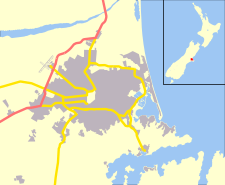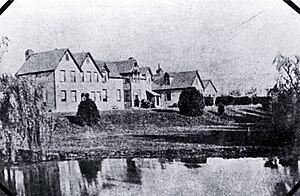Christchurch Hospital facts for kids
Quick facts for kids Christchurch Hospital |
|
|---|---|
| Canterbury District Health Board | |

Aerial view of Christchurch Hospital (2009)
|
|
| Geography | |
| Location | Riccarton Avenue, Christchurch, New Zealand |
| Coordinates | 43°32′04″S 172°37′32″E / 43.5344°S 172.6255°E |
| Organisation | |
| Funding | Government (District Health Board) |
| Hospital type | General |
| Affiliated university | University of Otago Christchurch School of Medicine |
| Services | |
| Emergency department | Yes |
| Helipad | (ICAO: NZJC) |
| Beds | 836 |
| History | |
| Founded | 1 June 1862 |
Christchurch Hospital is the biggest hospital in the South Island of New Zealand. It's a public hospital right in the middle of Christchurch city. It sits next to Hagley Park. This hospital helps people from all over the wider Canterbury area. The government helps pay for and run the hospital through the Canterbury District Health Board (CDHB).
Christchurch Hospital is a very important place for people with serious injuries. It's the main "trauma centre" for northern and central Canterbury. This means it's where people go if they have been badly hurt. It has the busiest Emergency Department (ED) in the South Island. It also treats more major injuries than almost any other hospital in New Zealand or Australia.
The Christchurch School of Medicine is also located at the hospital. This school is part of the University of Otago. It teaches medical students in their later years of study.
A new building called ‘Waipapa’ opened in 2020. It is located behind the older hospital buildings. Waipapa is where the hospital's urgent care services are now found. The Emergency Department is also inside Waipapa. The hospital's helipad is now on top of the Waipapa building. This new helipad replaced the old one in Hagley Park.
Contents
A Look Back: Hospital History
The idea for Christchurch Hospital started in 1861. The local government decided to spend money to build it. The first building was a simple two-story structure. It was built in Hagley Park on Riccarton Avenue. People protested because they didn't want a building in the park. But the hospital still opened on June 1, 1862. The very last of these original buildings were taken down in 1917.
In 2009, there were plans to update some of the hospital buildings. The idea was to build a new hospital with 450 beds. It would also have a helipad on the roof and more operating rooms. Construction was planned to start in 2011.
Building the New Waipapa
After some big earthquakes, the building plans changed. Over the next five years, Christchurch Hospital got a huge upgrade. This was the biggest investment ever in public health buildings in New Zealand. The new Acute Services Building, now called Waipapa, has many cool features:
- It has a total area of 62,000 square meters.
- There are 13 lifts inside the building.
- It was built with 6,000 tonnes of steel and over 100,000 bolts.
- The outside walls are made of 1,300 special panels.
- The building lets in lots of natural light.
- It has strong protection against earthquakes. This includes special parts that allow the building to move safely. Pipes for water and air conditioning also have special joints.
What's Inside Waipapa?
The Waipapa building is organized into different levels:
- Tower A (Levels 3 – 9): This part has wards for general surgery and blood vessel care. It also has areas for stroke patients and children's medical care. The Children’s Haematology and Oncology Centre (CHOC) is here too. The helipad is on top of this tower.
- Tower B (Levels 3 – 8): This tower is for brain and nerve surgery. It also has children's surgery and a special unit for bone marrow transplants. Young adults with cancer get support here. There are also areas for cancer treatment, bone problems, and general surgery.
- Level 2: This floor has areas for sterilizing equipment and offices for staff.
- Level 1: This level holds the Intensive Care Unit. This is where very sick patients get special care. It also has operating rooms and radiology (X-ray) services.
- Ground Floor: This is where the Emergency Department is. It also has areas for medical assessments and urgent care. More radiology services are here too.
- Lower Ground Floor: This floor has meeting rooms, shared workspaces, and changing rooms for staff.
Hospital's Role in Major Events
Christchurch Hospital has played a very important role in helping people during difficult times.
- In February 2011, after a big earthquake, the hospital helped many people. It took in 164 people who had serious injuries. One part of the hospital also had to be safely emptied.
- In 2019, after a tragic event, the hospital quickly helped many injured people. It admitted 49 people who needed urgent care. The hospital staff worked hard to provide the best possible care to everyone.
Important People
- Courtney Nedwill (1837–1920), a public health officer who worked with the hospital for 30 years.
- Catherine Stedman, a professor of medicine.
See also
 In Spanish: Hospital de Christchurch para niños
In Spanish: Hospital de Christchurch para niños



